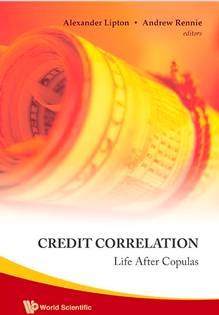Credit Correlation : Life after Copulas
Lipton, Alexander
Éditeur : WORLD SCIENTIFIC PUBLISHING
ISBN papier: 9789812709493
Parution : 2007
Code produit : 1135615
Catégorisation :
Livres /
Science /
Mathématique /
Actuariat et mathématiques financières
Formats disponibles
| Format | Qté. disp. | Prix* | Commander |
|---|---|---|---|
| Livre papier | En rupture de stock** |
Prix membre : 75,00 $ Prix non-membre : 78,95 $ |
*Les prix sont en dollars canadien. Taxes et frais de livraison en sus.
**Ce produits est en rupture de stock mais sera expédié dès qu'ils sera disponible.
Description
The recent growth of credit derivatives has been explosive. The global credit derivatives market grew in notional value from $1 trillion to $20 trillion from 2000 to 2006. However, understanding the true nature of these instruments still poses both theoretical and practical challenges. For a long time now, the framework of Gaussian copulas parameterized by correlation, and more recently base correlation, has provided an adequate, if unintuitive, description of the market. However, the increased liquidity in credit indices and index tranches, as well as the proliferation of exotic instruments such as forward starting tranches, options on tranches, leveraged super senior tranches, and the like, have made it imperative to come up with models that describe market reality better. This book, originally and concurrently published in the International Journal of Theoretical and Applied Finance, Vol. 10, No. 4, 2007, agrees that base correlation has outlived its usefulness; opinions of how to replace it, however, are divided. Both the top-down and bottom-up approaches for describing the dynamics of credit baskets are presented, and pro and contra arguments are put forward. Readers will decide which direction is the most promising one at the moment. However, it is hoped that, in the near future, models that transcend base correlation will be proposed and accepted by the market. Contents: Lévy Simple Structural Models (M Baxter); Cluster-Based Extension of the Generalized Poisson Loss Dynamics and Consistency with Single Names (D Brigo et al.); Stochastic Intensity Modeling for Structured Credit Exotics (A Chaposvsky et al.); Large Portfolio Credit Risk Modeling (M H A Davis & J C Esparragoza-Rodriguez); Empirical Copulas for CDO Tranche Pricing Using Relative Entropy (M A H Dempster et al.); Pricing and Hedging in a Dynamic Credit Model (Y Elouerkhaoui); Joint Distributions of Portfolio Losses and Exotic Portfolio Products (F Epple et al.); On the Term Structure of Loss Distributions: A Forward Model Approach (J Sidenius).























